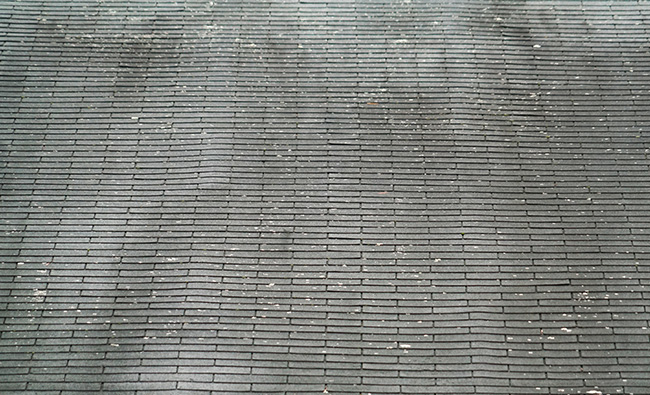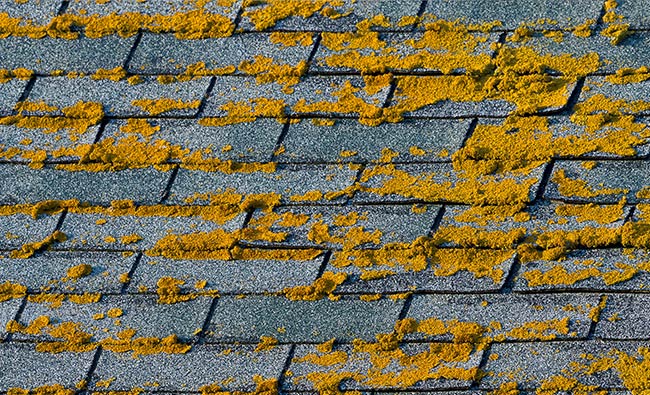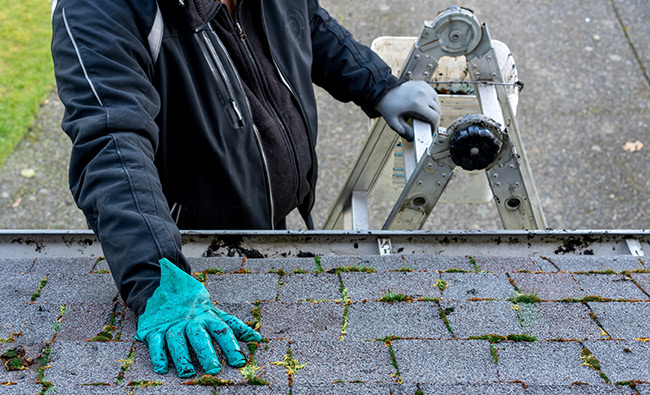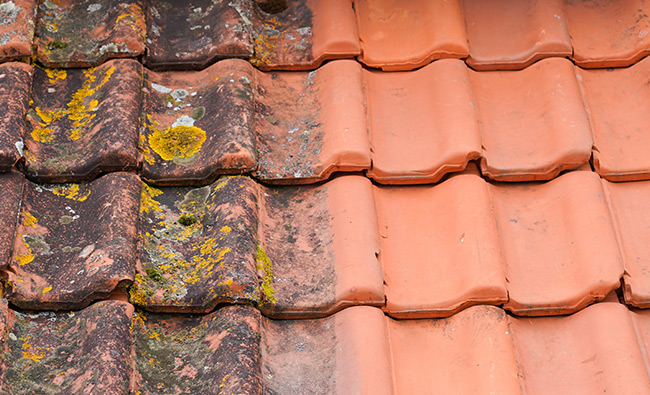
Key Takeaways
- Black streaks on asphalt roofs are primarily caused by the growth of Gloeocapsa magma algae, which thrive in warm, humid conditions and can deteriorate shingles over time.
- The presence of these black streaks can lead to increased cooling costs and potential structural damage, making it essential to address the issue promptly through cleaning and preventive measures.
- Investing in algae-resistant shingles and maintaining proper roof and gutter care are critical steps in preventing the recurrence of algae growth and extending the roof’s lifespan.
What Causes Black Streaks on Asphalt Roofs?
The primary cause of black streaks on asphalt roofs is the growth of Gloeocapsa magma, a type of cyanobacteria. This algae thrives on the limestone and minerals found in asphalt shingles, feeding off these materials and causing those dark, unsightly streaks that spoil your roof’s appearance. The warm and humid climates prevalent in many regions provide an ideal environment for this algae to flourish, leading to widespread issues for many homeowners.
Adding to the problem, trees that overhang roofs can exacerbate the situation by creating moist, shaded areas perfect for algae growth. These overhanging branches not only trap moisture but also drop organic matter onto the roof, further feeding the algae. Many homeowners often question, “Why are there streaks on my roof?” The answer is a combination of environmental factors and the composition of asphalt shingles.
Understanding these causes is the first step in addressing the issue. Recognizing that these black stains are more than just a cosmetic issue but a symptom of underlying biological processes allows for more informed management and prevention steps.
Impact of Algae Growth on Your Roof

Cyanobacteria gloeocapsa magma algae on your roof does more than create an aesthetic nuisance. Black streaks can significantly impact the integrity of your asphalt composition roofing shingles. Gloeocapsa magma algae growth can cause the shingles to deteriorate prematurely, leading to costly repairs or even a complete roof replacement if left unchecked. The tiny organisms feed on the limestone in the shingles, weakening them and making your roof less effective at protecting your home from the elements.
Beyond structural damage, the black streaks caused by algae can also lead to increased energy costs. The dark streaks absorb more heat, causing your home to heat up more in the summer, leading to higher cooling expenses. This additional heat can also stress your roof covering, further accelerating the deterioration of the shingles. Ignoring these streaks can thus result in not only aesthetic and structural damage but also financial strain.
Moreover, the presence of green algae deposits can signal other potential issues, such as algae discoloration and algae staining. For instance, it could indicate that your roof is not draining properly or that there are areas where moisture is consistently present. Taking steps to address the algae can help you identify and rectify these underlying problems before they lead to even more significant damage.
DIY Methods to Remove Black Streaks
Several DIY methods are available for those who prefer a hands-on approach to removing black streaks from their roof. Among the most effective is a bleach solution, which can kill the algae causing the streaks. However, it’s crucial to avoid using a pressure washer, as this can damage the asphalt shingles.
Each method has its own set of steps and precautions, which we will detail in the following subsections.
Using a Bleach Solution
A bleach solution is one of the most effective ways to remove black algae streaks from your roof. This method involves mixing one part chlorine bleach with three parts water. The solution is then applied to the affected areas, allowing it to soak for 15-20 minutes before rinsing. This process can effectively lighten dark streaks and restore the appearance of your roof.

Safety remains paramount when using bleach. Always wear protective gear such as gloves and goggles to avoid skin and eye irritation. Additionally, be sure to use proper ladder techniques and avoid working on wet or slippery surfaces to prevent accidents. The bleach solution can be a powerful ally in your roof cleaning arsenal, but it must be handled with care.
While bleach can effectively remove black stains, it should be used sparingly in humid environments. Excessive use can create a breeding ground for new algae, as the bleach can kill off beneficial organisms that help keep the algae in check. Therefore, while bleach can help remove dark streaks, it should be part of a broader maintenance routine rather than a standalone solution.
Avoiding Pressure Washers
While using a pressure washer for roof cleaning might be tempting, this method is generally not recommended for asphalt shingles. The high pressure can cause significant damage, stripping away the protective granules and leading to premature deterioration of the shingles. Instead of removing the algae, you might end up with an even bigger problem on your hands.
If you must use a pressure washer, operating it on its lowest setting is crucial to minimize potential damage. However, alternative cleaning methods, such as using a bleach solution or manual scrubbing with a soft-bristle brush, are safer and can be just as effective at removing black stains from your roof.
Employing these gentler methods helps preserve the integrity of your asphalt shingles while keeping your roof clean.

Professional Roof Cleaning Options
Hiring a professional service offers numerous benefits for those who prefer to leave roof cleaning to the experts. Professional roof cleaners bring expertise and specialized solutions that can effectively remove black streaks without the risks associated with DIY methods. They commonly use algaecides and low-pressure methods to safely clean roofs, ensuring that the shingles are not damaged in the process.
Severe algae infestations can shorten a roof’s lifespan by up to ten years. This makes professional cleaning not just a matter of convenience but a critical step in preserving your roof’s longevity. Additionally, professional services can identify and address underlying issues that may be contributing to algae growth, such as poor drainage or ventilation problems.
When choosing a professional roof cleaning service, it’s essential to consider their experience, reviews, licensing, and insurance. A reputable company will also offer a warranty on their work, giving you peace of mind that the job will be done right. Investing in professional roof cleaning can ultimately save you time and money and the hassle of dealing with more severe roofing issues down the line.
Preventing Black Streaks on Asphalt Shingles
Preventing black streaks on your asphalt roof is always better than dealing with them later. One of the most effective ways to prevent algae growth is by regularly trimming tree branches that overhang your roof. This minimizes shade and moisture, creating an environment less conducive to algae growth. Maintaining clean gutters is also crucial, as it ensures proper drainage and reduces the risk of water pooling, which can promote algae formation.
Another powerful preventive measure is the installation of zinc or copper strips along the roof ridge. These strips release small amounts of metal when it rains, which inhibits algae growth and helps keep your roof clean. Some algae-resistant shingles incorporate copper-lined mineral granules, providing long-term protection against algae. This combined approach of regular maintenance and the use of algae-inhibiting materials can effectively reduce algae growth and prolong the lifespan of your roof.
Preventing black streaks not only maintains the aesthetic appeal of your home but also preserves the integrity of your roof. Taking these proactive steps helps avoid the hassle and expense of dealing with extensive algae growth and subsequent roof damage.
The Role of Algae-Resistant Shingles

Algae-resistant shingles are an excellent investment for homeowners looking to prevent black streaks on their roofs. These shingles are specifically engineered with algae-resistant mineral granules that prevent the growth of Gloeocapsa magma algae. The copper or zinc granules slowly release copper ions that inhibit algae formation, keeping your roof clean and algae-free.
Shingle manufacturers have developed algae-resistant shingles to reduce maintenance needs and prolong the roof’s lifespan. These shingles not only help prevent algae growth but also maintain their color and appearance for more extended periods. Algae-resistant shingles can significantly reduce the frequency of roof cleaning and the associated costs.
Investing in algae-resistant asphalt shingles is a proactive step in roof maintenance. Choosing shingles with algae-inhibiting properties allows for a cleaner, more aesthetically pleasing roof with less effort. This advanced technology offers long-term benefits, making it a wise choice for any homeowner concerned about algae growth.
Regular Maintenance for a Clean Roof
Regular maintenance is key to keeping your roof clean and free from black streaks. Routine inspections allow you to catch issues like loose shingles early, preventing more extensive damage. Regularly clearing debris from your roof and gutters ensures proper drainage and reduces moisture accumulation, which can harbor algae.
Professional roof cleaning services can also play a crucial role in maintaining your roof. These services can remove harmful growths without causing damage, significantly prolonging your roof’s lifespan. Additionally, using algae-resistant shingles can further reduce maintenance needs, keeping your roof looking clean for extended periods.
Implementing a regular maintenance routine not only preserves your home’s aesthetic appeal but also protects your roof’s structural integrity. Proactively addressing potential problems before they escalate ensures your roof remains a sturdy and reliable barrier against the elements.
Black Streak on Roof Summary
In conclusion, black streaks on asphalt roofs are a common issue caused by Gloeocapsa magma algae. These streaks can lead to both aesthetic and structural damage, increasing energy costs and potentially necessitating costly repairs. DIY methods, such as using a bleach solution, can be effective. Still, professional cleaning services provide greater expertise and safety. Preventive measures like trimming trees, maintaining gutters, and using algae-resistant shingles are essential for keeping your roof clean and extending its lifespan. By taking proactive steps, you can preserve your roof’s beauty and functionality for years to come.
Streak on Roof Frequently Asked Questions
What causes black streaks on my asphalt roof?
Black streaks on asphalt roofs are primarily caused by the algae Gloeocapsa magma, which feeds on the limestone and minerals in the shingles. This algae growth can result in unsightly discoloration, necessitating regular maintenance to preserve your roof’s appearance.
How can I prevent black streaks from forming on my roof?
To prevent black streaks on your roof, trim overhanging tree branches, keep your gutters clean, and consider installing zinc or copper strips along the roof ridge. These measures will help maintain the roof’s integrity and appearance.
Are algae-resistant shingles effective in preventing black streaks?
Algae-resistant shingles effectively prevent black streaks as they are designed with copper-infused granules that inhibit algae growth, thus maintaining a cleaner roof over time.
Is it safe to use a pressure washer for roof cleaning?
Using a pressure washer for roof cleaning is unsafe, as it can damage asphalt shingles. Opt for a bleach solution or consider hiring professional cleaning services instead.
How often should I have my roof professionally cleaned?
It is advisable to have your roof professionally cleaned every few years, depending on the extent of algae growth and your local climate, to maintain its integrity.
(352) 293-2449